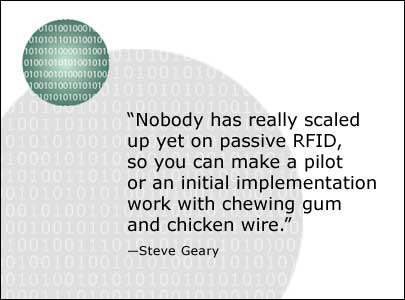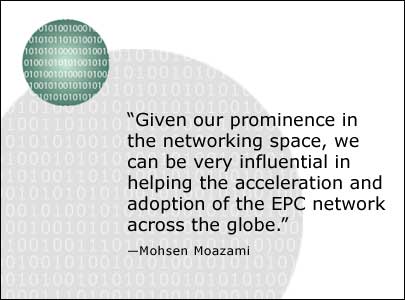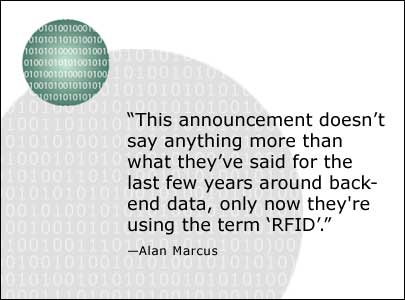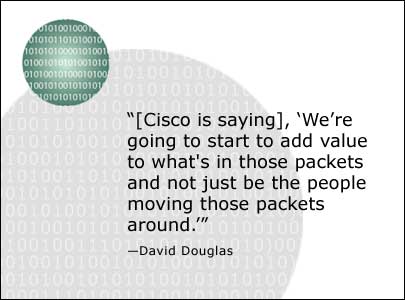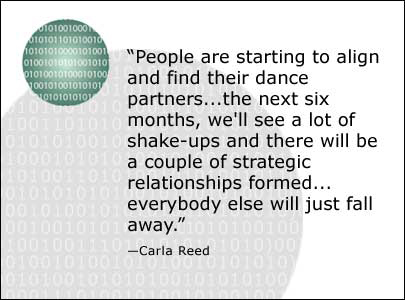Aug 28, 2005By Bennett Voyles
"It's the network, stupid." That's essentially been the mantra Cisco Systems has recited since the mid-'90s, when business first discovered the Internet, and it's the mantra Cisco sales teams are reciting now, in this brave new world of RFID.
"The whole world in the past has been very focused on the interoperation of the reader and the tag. Very few people have been focused on what happens with the reader," says Mohsen Moazami, vice president of the Internet Business Solutions Group at Cisco Systems in San Jose, Calif.
Cisco is trying to change that, by getting companies with RFID pilot projects to focus less on the tags and readers, or interrogators, and more on how their growing RFID programs will be knit together once they are rolled out. In May, the company announced its new RFID-Ready Networks initiative, branding a selection of hardware and services it already provides for use in building data networks for RFID projects.
Of course, Cisco's spin that "the network's the thing in RFID" is a self-serving thesis, since the company sells the routers that make high-speed data networks run. No doubt, a Cisco flour company would tell bakers to focus on the dough, not the pie filling. Still, analysts say the Cisco mantra is likely to prove true once again in the context of RFID.
The small scale of many RFID pilot programs so far has made attention to network operations less of a concern than it probably will be in the long run, say supply chain experts. "Nobody has really scaled up yet on passive RFID, so you can make a pilot or an initial implementation work with chewing gum and chicken wire," says Steve Geary, a partner with Supply Chain Visions, a consulting firm headquartered in Bellevue, Wash.
With the new program, Cisco Systems is trying to encourage companies to move beyond the chicken wire stage. In seven to 10 years, Cisco warns in its sales literature, "the density of readers, the volume of data that is created and transmitted, and the potential uses of the information will be staggering." Rather than jury-rigging a system that will need to be ripped out later on, Cisco's RFID sales teams are advising supply chain executives to build something scalable now so it can be extended as data needs grow.
Teaching an Old Network New Tricks
From the point of view of a long-time Cisco customer, the good news about the company’s vision of an RFID network is that it's not much different than a conventional Cisco-supported data network. In many ways, in fact, it is the same old network. Cisco claims RFID data can be routed over the same pipes that carry packets of data for Internet, video and voice over IP (VoIP) services now. There is no need to build a separate network for RFID deployments—it can be supported on existing LAN infrastructures based on Cisco switches and routers, the company explains.
Cisco expects that initially, companies will deploy RFID systems as "islands" within their enterprise networks, primarily using wired, Ethernet-attached RFID interrogators to set up systems that aren't fully integrated within their larger data network.
The products Cisco recommends using to support such a configuration will include Cisco Catalyst desktop switches, which will connect to RFID interrogators, and a second set of switches that will connect the desktop switches with the network backbone. Eventually, when wireless handheld readers become the norm, the firm plans to roll out its Aironet wireless routers, which will be used to connect those wireless devices to the network.
Even though RFID data is similar to other kinds of data, integrating all that information into a single pipe does present one major challenge: RFID tags generate a massive volume of repetitive information. To filter out all that redundant data, Cisco's idea is to build a network "intelligent enough to know that this is an important piece of data—my manager needs to get it—or this is data that does not matter [so] don't go through the cost of transporting it, backing it up, storing it, recovering it, restoring it and ending up with terrabytes and terrabytes of unnecessary data," says Cisco's Moazami.
According to Cisco, the Catalyst platform can be programmed to give RFID packets a lower priority than other kinds of data, such as a VoIP telephone call. This can be done through the use of Cisco's quality of staging (QoS) technology, a function within Cisco's Internetwork Operating System (IOS) that enables routers to sort data packets by type and priority, while at the same time maintaining the traffic flow.
That interoperability of Cisco's equipment with the needs of RFID networks is probably no accident."Cisco has been involved in RFID for quite some time," says Erik Michielsen of ABI Research in Oyster Bay, N.Y. Although most RFID projects have been of limited scale so far, he explains, the company has tried to forge strong alliances and partnerships with RFID reader manufacturers and middleware vendors.
Cisco's Moazami, for instance, is on the board of governors of EPCglobal, the global standard-setting body for RFID. He believes Cisco's potential contribution to EPCglobal will be "invaluable."
"Cisco has a long tradition of building on top of open, nonproprietary technology, and we've been very influential on standards bodies in helping to adopt and promote widespread industry standards," Moazami says. "That experience is invaluable to EPCglobal." At the end of the day, Moazami maintains, RFID is one more network. "Given our prominence in the networking space, we can be very influential in helping the acceleration and adoption of the EPC network across the globe," he says.
Looking ahead, Michielsen of ABI Research predicts that Cisco will try to leverage that expertise with its clients, as well. "You're going to find that Cisco is going to want to step in and manage the network connectivity," he says "and also really help tie that to the enterprise."
What's New About an "RFID-Ready Network"?
But if an RFID-ready network is simply made up of equipment that also happens to be useful for routing RFID data, what's really new about Cisco's RFID-Ready Networks initiative?
Not much, according to Alan Marcus, vice president for marketing for the wireless networking division of Symbol Technologies, a Holtsville, N.Y.-based provider of handheld data devices, including RFID interrogators. "This announcement doesn't say anything more than what they've said for the last few years around back-end data, only now they're using the term 'RFID,'" he says.
Cisco has always had a vision that the network will grow, and as it grows, the routing systems will need to become more intelligent at the edges, explains Marcus, whose firm knows Cisco as both partner and competitor, depending on the product. Now, Cisco is "just adding the newest technology words," he says. "It makes perfect sense that that would occur, but I don't see anything different than what it has been talking about for years."
Supply Chain Visions's Geary agrees. Cisco, according Geary, believes RFID packets are "just a different sort of data, flying around on the network." What the company is trying to do is to "provide the capabilities that are required to support this new data source," he says. While Cisco has forecast the growth of network data needs in the past, its timing in its new RFID-Ready Networks marketing push may be right.
David Douglas, senior vice president for products and strategy for ConnecTerra—a Cambridge, Mass., firm that provides RFID middleware to help companies manage their RFID infrastructure, filter tag data and integrate that data with their business applications—says he is seeing more demand for network expertise in RFID deployments. What’s more, he says he "know[s] for a fact" that Cisco is getting calls now from clients of his who are looking for help in trying to bring RFID deployments to scale.
Places that have scarcely had any data networks, such as retail stores linked to the Internet by only a slow 100-kilobit-per-second connection, are going to need network support now, he explains. Cisco's background should be helpful in developing ways, for instance, to work out systems in monitoring and repairing RFID interrogators in remote locations. Already, Douglas states, Cisco has had a lot of experience with equipment such as routers for credit card readers in stores, on which on-the-spot maintenance is unlikely.
An example of such practical work in simplifying systems is Cisco's Power over Ethernet (PoE) option, which Moazami says could save "tens, if not hundreds, of millions of dollars" in a large deployment of RFID readers by enabling the use of one wire to carry both power and data.
Adding More Intelligence to RFID Networks
Ultimately, Moazami sees Cisco's key challenge in RFID deployments as creating hardware and software that can ensure the network stays secure from unauthorized use, yet remains open enough to be used by multiple partners in the supply chain.
"Network security and manageability across this value chain become a very obvious yet complex value proposition. If I need to be real time with my suppliers in Southeast Asia, and they need to know what I see and I need to see what they see, a whole bunch of stuff has to work in between to make that happen," he says.
While Cisco believes its current technology can meet some of those needs, the company recently announced an initiative to add more value to its networking products by incorporating capabilities previously performed by servers, such as security, into the network itself. The company also plans to make it easier to combine different kinds of data—RFID data included.
In June, Cisco announced it was going to begin working with ConnecTerra and more than 20 other companies to create what it calls Application-Oriented Networking (AON), technology it claims moves "beyond the packet level to read application-to-application messages flowing within the network—such as purchase orders, investment transactions or shipment approvals."
In other words, Douglas explains, Cisco is saying, "'we're going to start to add value to what's in those packets and not just be the people moving those packets around.'"
For RFID deployments, say experts, this evolution should prove helpful. A more intelligent network should make it even easier to set priorities and restrictions for different kinds of data—and to meet the kinds of challenges Moazami describes in creating networks across extended supply chains that are both secure and transparent.
Cisco recently announced one other RFID-specific initiative: a system that can track the locations of active RFID tags. In May, the firm released a new Wi-Fi-based location tracking system, the 2700 Series Wireless Location Appliance. The system can simultaneously track thousands of Wi-Fi-enabled computers and other 802.11 devices operating within a wireless local area network (WLAN). Integrated with mapping technology developed by PanGo Networks of Framingham, Mass., this $14,995 system is being marketed initially to hospitals, where keeping track of equipment can be a time-consuming activity (see Cisco, PanGo Unveil Tracking System).
Michael Campbell, PanGo's executive vice president for business development, points out that simply locating equipment can often be a problem. Campbell says one doctor joked to him that it takes eight hours to perform maintenance on an infusion pump: "seven hours to find it, one hour to do it."
The PanGo Locator is divided into an asset-tracking module, which can generate lists of assets by location, and a mapping feature. According to Campbell, the system can track between 2,000 and 4,000 assets to which Wi-Fi RFID tags have been attached.
Beyond health care, Cisco is considering marketing this product to warehouses, offices and data centers. At the latter, locating the physical location of a server is sometimes a problem, reports Pradeep Gandhi, Cisco's business development manager for the product.
Down the line, Moazami predicts, the use of active Wi-Fi tags will lead to a variety of very useful applications. "For example, if I have a forklift that is Wi-Fi-enabled [and] moves around the building, just being able to triangulate the position of this forklift to where it needs to go and what it needs to pick up...is a very powerful scenario," he says.
But Symbol’s Marcus, whose firm competes with Cisco in some spaces such as wireless access points, says he doesn't believe Cisco will necessarily remain in the location business. Like many companies, he says, Cisco has a history of launching pilot projects to demonstrate the utility of a technology, then seeing that technology as outside its core business and exiting the arena when other suppliers enter. "Cisco has long tested the waters with devices that are nontraditional for Cisco," he says. "The company stays on it for a short time and may back out."
Controlling the Board
Some observers say the RFID-Ready Networks program may be seen less as a technical initiative than as a marketing gambit—a reminder to its clients that Cisco is playing a role in RFID. Mike Liard, practice director of Venture Development Corp. in Niantic, N.Y., describes the initiative as both a marketing play "and a stake in the ground"—a notice to its competitors and potential competitors that it's serious about RFID.
Geary says the growth of RFID is now at a classic stage of a technology evolution, when many companies think they have the answer, or part of the answer, to the question of how RFID networks are going to run. "You've got people coming into the space from all sorts of different directions. You've got the device managers—the readers—you've got the tag manufacturers, the Aliens of the world or the Symbols of the world, you've got the networking guys like Cisco, or the integration guys, and every one of these folks thinks that they have the answer," he says.
Now that RFID development is gearing up, many service and hardware companies are beginning to choose the segments where they intend to compete, and to find the partners they need to complete their offerings.
"People are starting to align and find their dance partners," says Carla Reed, head of the global logistics and distribution practice of ChainLink Research, a supply chain research firm based in Cambridge, Mass. "I think basically, the next six months we'll see a lot of shake-ups, and there will be a couple of strategic relationships formed. Those will be the players, and everybody else will just fall away."
Symbol’s Marcus predicts more competition for Cisco, from firms that include Juniper, Nortel and Alcatel—though Cisco retains a marketing edge. "These guys are all building highly capable, very large IP-packet movers that are all intelligent. Cisco doesn't have the corner on the intelligent market, although they have the corner on the marketing of that intelligent market," he says.
But Geary believes Cisco will remain largely above the fray. "This isn't Cisco versus the integrator," he says. "This is Cisco facilitating the implementation because they're almost agnostic about who wins. They're just trying to facilitate network traffic, expanding the Cisco umbrella to a new class of devices, and to a new development community."
Cisco's Moazami says the firm intends to stay focused on the network. "Imagine the value chain of RFID," says Moazami. "You start with the tag, and then you hit a reader, and then this reader sits in a cloud, which we call the network, and this network ties to back-office functions. We are very focused on and interested in the cloud."
One area, however, that clearly seems likely to remain outside Moazami's silver-lined cloud is the manufacturing of tags and readers—a business, he says, Cisco has no intention of entering. Moazami, in fact, is almost dismissive about the tag and reader segments. "RFID is a technology that's been around since the '50s," he maintains. "What is exciting to us is the networked RFID, and the combination of RFID and the Internet as a subset of the overall sensor networks."

